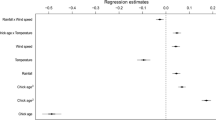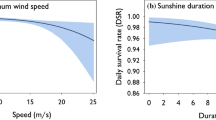Abstract
Heavy and frequent rain, low temperatures, and strong winds may decrease adult foraging time, cause thermoregulatory stress on nestlings, and lead to nest damage or destruction, all of which can negatively affect breeding success. However, certain parental behaviours can mitigate these potentially negative effects of inclement weather. We examined how parents could mitigate these negative weather effects by adjusting three behaviours—nest attendance, prey deliveries, and nest maintenance—before, during, and after storms at 11 nests of the at-risk Ferruginous Hawk (Buteo regalis) in Canada. Female adults spent an increasing amount of time on the nest as wind speed increased. Similar numbers of prey were delivered before and after storms, suggesting that Ferruginous Hawks do not compensate for lost foraging time. They appeared to demonstrate an ability to detect approaching storms, possibly by responding to falling barometric pressure cues, and may have mitigated the risk of nest damage by increasing their nest maintenance behaviours. Our study is among the first to observe storm preparation behaviour, and indicates that some raptorial birds have the ability to alter nesting behaviour in response to approaching inclement weather.
Zusammenfassung
Königsbussarde (Buteo regalis) verändern das elterliche Verhalten bei heraufziehenden Stürmen Starke und andauernde Regenfälle, niedrige Temperaturen und starke Winde können die Zeit der Nahrungssuche von Adulten verringern. Dies verursacht thermoregulatorischen Stress bei den Nestlingen und kann zu Schaden oder Vernichtung der Brut führen, was insgesamt den Bruterfolg negativ beeinflussen kann. Dennoch können bestimmte elterliche Verhaltensweisen diese potentiell negativen Schlecht-Wetter-Effekte abmildern. Wir untersuchten, wie Eltern diese negativen Wettereinflüsse durch die Anpassung von drei Verhaltensweisen abschwächen konnten: Anwesenheit am Nest, Beuteübergaben und Brutpflege vor, während und nach Stürmen an 11 Nestern des gefährdeten Königsbussard (Buteo regalis) in Kanada. Adulte Weibchen verbrachten mehr Zeit auf dem Nest mit zunehmender Windgeschwindigkeit und stärker werdenden Regenfällen. Vor und nach den Stürmen wurden ähnliche Anzahlen an Beuteobjekten eingetragen, was darauf hindeutet, dass Königsbussarde verlorene Zeiten zur Nahrungssuche nicht kompensieren. Königsbussarde scheinen die Fähigkeit zu haben, heraufziehende Stürme zu erkennen, in dem sie auf fallenden Luftdruck reagieren und das Risiko eines Brutverlustes durch zunehmende Brutpflege minimieren. Unsere Studie gehört zu den ersten, die sturmvorbereitendes Verhalten beobachten konnte und zeigt, dass Greifvögel in der Lage sind, ihr Brutverhalten als Antwort auf raue Witterungsbedingungen anzupassen.


Similar content being viewed by others
References
Aebischer NJ (1993) Immediate and delayed effects of a gale in late spring on the breeding of the Shag Phalacrocorax aristotelis. Ibis 135:225–232
Alberta Ferruginous Hawk Recovery Team (2009) Alberta Ferruginous Hawk Recovery Plan 2009–2014. Alberta Recovery Plan No. 17, 44 pp
Anctil A, Franke A, Bêty J (2014) Heavy rainfall increases nestling mortality of an arctic top predator: experimental evidence and long-term trend in peregrine falcons. Oecologia 174:1033–1043
Bechard MJ, Schmutz JK (1995) Ferruginous Hawk (Buteo regalis), The Birds of North America Online. In: Ithaca: Cornell Lab of Ornithology. http://bna.birds.cornell.edu/bna/species/172. Accessed 10 Feb 2015
Breuner CW, Sprague RS, Patterson SH, Woods HA (2013) Environment, behavior and physiology: do birds use barometric pressure to predict storms. J Exp Biol 216:1982–1990
Burger J (1979) Nest repair behavior in birds nesting in salt marshes. J Comp Physiol Psychol 93:189–199
Burnham KP, Anderson DR (2002) Model selection and multimodel inference: a practical information-theoretic approach. Springer, New York
Cain SL (2010) Time budgets and behavior of nesting bald eagles. Bald Eagles in Alaska. Hancock House Publishers., Blaine, pp 73–94
Cartar RV, Montgomerie RD (1987) Day-to-day variation in nest attentiveness of white-rumped sandpipers. Condor 89:252–260
Dawson RD, Bortolotti GR (2000) Reproductive success of American kestrels: the role of prey abundance and weather. Condor 102:814–822
De Smet KD, Conrad MP (1991) Status, habitat requirements, and adaptations of Ferruginous Hawks in Manitoba. In: Holroyd G, Burns G, Smith HC (eds) Proceedings of the second endangered species and prairie conservation workshop, Natural history occasional paper 15, p 219–221
Ecological Framework of Canada (1999) Mixed grassland. http://ecozones.ca/english/region/159.html. Accessed 27 Apr 2014
Environment Canada (2013) Climate—accessing the data. http://www.climate.weatheroffice.gc.ca/climateData/canada_e.html. Accessed 02 Feb 2013
Giovanni MD, Boal CW, Whitlaw HA (2007) Prey use and provisioning rates of breeding Ferruginous and Swainson’s Hawks on the southern Great Plains, USA. Wilson J Ornithol 119:558–569
Intergovernmental Panel on Climate Change, IPCC (2007) Climate change 2007: synthesis report, Fourth Assessment Report. http://www.ipcc.ch/. Accessed 02 Apr 2014
Jovani R, Tella JL (2004) Age-related environmental sensitivity and weather mediated nestling mortality in white storks Ciconia ciconia. Ecography 27:611–618
Konter A (2007) Response of Great Crested Grebes Podiceps cristatus to storm damage of nests. Waterbirds 30:140–143
Manitoba Conservation (2015) Ferruginous Hawk fact sheet. Province of Manitoba. http://www.manitoba.ca/conservation/wildlife/sar/fs/ferhawk.html. Accessed 28 May 2015
Martinez JE, Jimenez-Franco M, Zuberogoitia I, Leon-Ortega M, Calvo JF (2013) Assessing the short-term effects of an extreme storm on Mediterranean forest raptors. Acta Oecol 48:47–53
McGowan A, Cresswell W, Ruxton GD (2002) The effects of daily weather variation on foraging and responsiveness to disturbance in overwintering Red Knot Calidris canutus. Ardea 90:229–237
Metcalfe J, Schmidt KL, Kerr WB, Guglielmo CG, MacDougall-Shackleton S (2013) White-throated sparrows adjust behaviour in response to manipulations of barometric pressure and temperature. Anim Behav 86:1285–1290
Michener GR, Koeppl JW (1985) Spermophilus richardsonii. Mamm Species 243:1–8
Migaj A, Kemper CM, Downey BL (2011) Ferruginous Hawk artificial nest poles: inventory and construction protocol. Alberta sustainable resource development, fish and wildlife division, Alberta Species at Risk Report No. 140
Moltzahn AJ (2010) The 2010 ferruginous hawk inventory and population analysis. Alberta sustainable resource development, Fish and wildlife division, Alberta Species at Risk Report No. 139
Palmer RS (1988) Ferruginous Hawk. In: Handbook of North American birds. vol 5, pt 2. Yale University Press, New Haven, pp. 135-151
Polak M, Kasprzykowski Z (2013) The effect of weather conditions on the breeding biology of the Eurasian Bittern Botaurus stellaris in eastern Poland. Ethol Ecol Evol 25:243–252
Powers L (1981) Nesting behavior of the Ferruginous Hawk (Buteo regalis). Dissertation, Idaho State University
Radford AN, McCleery RH, Woodburn R, Morecroft MD (2001) Activity patterns of parent Great Tits Parus major feeding their young during rainfall. Bird Study 48:214–220
Redpath SM, Arroyo BE, Etheridge B, Leckie F, Bouwman K, Thirgood SJ, Brooks HE (2002) Temperature and hen harrier productivity: from local mechanisms to geographical patterns. Ecography 25:533–540
Reese JG (1970) Reproduction in a Chesapeake Bay osprey population. Auk 87:747–759
Rodgers JA, Wenner AS, Schwikert ST (1988) The use and function of green nest material by Wood Storks. Wilson Bull 100:411–423
Schmutz J, Hungle D (1989) Populations of Ferruginous and Swainson’s Hawks increase in synchrony with ground-squirrels. Can J Zool 67:2596–2601
Schmutz JK, Fyfe RW, Moore DA, Smith AR (1984) Artificial nests for Ferruginous and Swainson’s Hawks. J Wildl Manag 48:1009–1013
Schmutz JK, Gerard MA, Court GS, Nelson RW (2014) Parental care by lone male Ferruginous Hawks (Buteo regalis), Rough-Legged Hawks (Buteo lagopus), and Great Horned Owls (Bubo virginianus) was Limited to providing food. Can Field-Nat 128(2):145–150
Sergio F (2003) From individual behaviour to population pattern: weather-dependent foraging and breeding performance in black kites. Anim Behav 66:1109–1117
Species at Risk Act, SARA (2015) Species Profile—Ferruginous Hawk. Government of Canada. http://www.sararegistry.gc.ca/species/speciesDetails_e.cfm?sid=47. Accessed 20 Feb 2015
von Bartheld C, Giannessi F (2011) The paratympanic organ: a barometer and altimeter in the middle ear of birds. J Exp Zool B Mol Dev Evol 316B:402–408
White CM, Thurow TL (1985) Reproduction of Ferruginous Hawks exposed to controlled disturbance. Condor 87:14–22
Acknowledgments
We would like to thank the numerous field and research assistants who helped make this project a success, as well as the following funding partners for their support: Canadian Wildlife Service/Environment Canada, Climate Change and Emissions Management Corporation, Nexen Inc., AltaLink, L.P., Cenovus Energy, Petroleum Technology Alliance of Canada, Suncor Energy, Alberta Environment and Sustainable Resource Development, Canadian Department of National Defence, Agriculture and Agri-Food Canada, Alberta Conservation Association, Natural Sciences and Engineering Research Council of Canada, Saskatchewan Ministry of Environment, and Alberta Sport, Recreation, Parks & Wildlife Foundation. All research was performed according to Canadian law. Comments from two anonymous reviewers greatly improved previous versions of this manuscript.
Author information
Authors and Affiliations
Corresponding author
Ethics declarations
Ethical approval
All applicable international, national, and/or institutional guidelines for the care and use of animals were followed. This project was approved by University of Alberta Animal Care (#724).
Conflict of interest
The authors declare that they have no conflicts of interest.
Additional information
Communicated by O. Krüger.
Rights and permissions
About this article
Cite this article
Laux, C.M., Nordell, C.J., Fisher, R.J. et al. Ferruginous Hawks Buteo regalis alter parental behaviours in response to approaching storms. J Ornithol 157, 355–362 (2016). https://doi.org/10.1007/s10336-015-1288-0
Received:
Revised:
Accepted:
Published:
Issue Date:
DOI: https://doi.org/10.1007/s10336-015-1288-0




